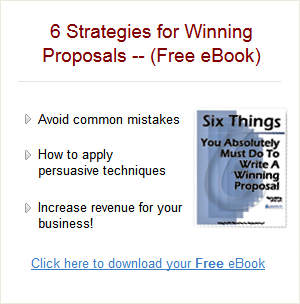Presenting to the Client After Proposal Submittal—Part One
This article is directed at those who have already submitted their proposal and have been invited to make a presentation to a selection panel. If your client has required you to make your actual proposal in person, many of these tips will help, but you must address other needs as well. We’ll talk about those kinds of presentations in a future article.
You’ve prepared your proposal, submitted it, and have just learned you have been short-listed. Now you must actually face the people who have read your proposed solution. You need to justify your claims in person. It can be a very nerve-wracking 30 minutes. Here are some tips that can help reduce the anxiety all presenters face.
As you begin to develop the content for your presentation, keep this uppermost in your mind:
The client already knows you are technically competent. That’s why you are in the interview. The interview is about two main things:
|
As you decide how to organize your presentation, remember these four rules:
- If the client has given you a format, follow it
- You must make sure the client knows you understand the problem at hand
- You must make sure you have a solution that meets the client’s needs
- You must make sure you call out clear and direct benefits of your solution to the client
And remember, you don’t have a lot of time to say it. So, here’s another rule to follow:
- Keep it simple
How you organize the presentation depends a lot on what you have to say. It depends on the client’s needs and hot buttons. It depends on the complexity of the problem you’re proposing to solve and your solution to it. Here’s one thing you should not do:
- Don’t follow your proposal format!
This is a presentation. It’s supposed to be a high-level overview of your solution and the benefits you bring to this project. In short: It’s a sales pitch!
Think of the presentation as an oral executive summary.
If you wrote an executive summary in your proposal-and you should have, either as a stand-alone section or as a cover letter-you can use it as the jumping off point for your short-list presentation. In fact, the next time you do write an executive summary, think of it as the blueprint for the presentation that will inevitably follow.
Your presentation should follow the same rules as an executive summary. When you put your pitch together, do the following:
Determine a “theme” or main message and make everything you say-every graphic you use-point to it. A presentation that revolves around a central message is easier to develop and deliver. From the audience’s standpoint, it’s a whole lot easier to listen to. It’s more interesting than just a bunch of techno-speak strung together, or a disjointed series of things you’ll do that seem to have no continuity. You will be able to control the listeners’ attention a lot more completely if you have a central theme they can get interested in.
Focus on the client’s hot buttons. Your theme needs to grow out of your proposal win strategy. It must be directly related to what the client wants most. If it’s not-if you are off target-the audience will drift away.
This can seem like a risky approach; you’re putting all your eggs in one basket. But if it’s the right basket-if you have nailed your client’s hot buttons accurately-the risk is really pretty low.
Don’t stop with the theme. Every single time you can point out how what you will do will benefit the client, make sure you do. Pepper your presentation with benefits, large and small. The idea is to make your team as attractive as possible, to make it impossible for the client to not select you.
Give highlights of your solution. You need to talk about what you will do and how you will do it. This is, after all, what the client is paying for. But, of all the possible things you will do during the project, of all the many activities and approaches you will take, which ones should you mention in the 15 minutes you are allotted? What’s your basis for selecting the topics you will address?
Once again, look to the client for direction. What are the things that he thinks are important? Remember that every competitor-every team that presents-is about equally capable technically to do the work. And each team will likely come up with a similar approach; there ain’t too many ways to do the sorts of projects you do.
But if you focus on the issues that are critical to the client, then you score points.
Avoid minutia, jargon and too much detail. Too much detail is boring. It’s probably boring to you. Think of how boring it’s going to be to a panel that has to listen to three, four or five presentations in one day. Think about the people who are not technically savvy but who have a vested interested in the selection (and there will be some of them. Maybe even most of them).
You want to talk technical. It’s where your comfort zone is. It’s very easy for you to lapse into a nuts-and-bolts discussion. The panel, however, doesn’t want to hear it, at least not as much as you.
Show you are competent, professional and willing to help. You want to leave the overall impression that you are technically competent professionals with all the skills, the tools and the people to get the technical job done. Plus, you want to leave them with the feeling that you are willing to help, that you are service-oriented (if you don’t, the winning firm will!) and that you genuinely want to help the client solve her problems, ease her pain.

